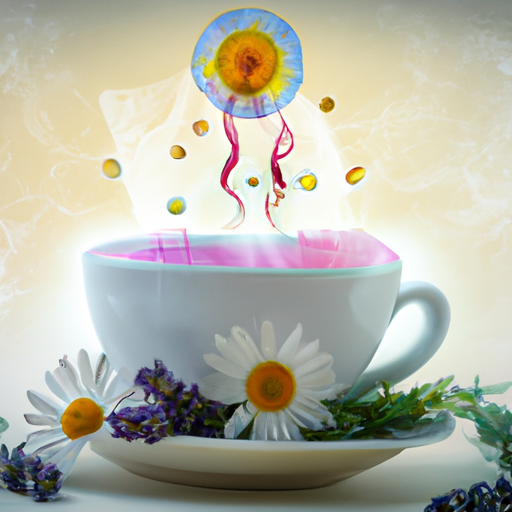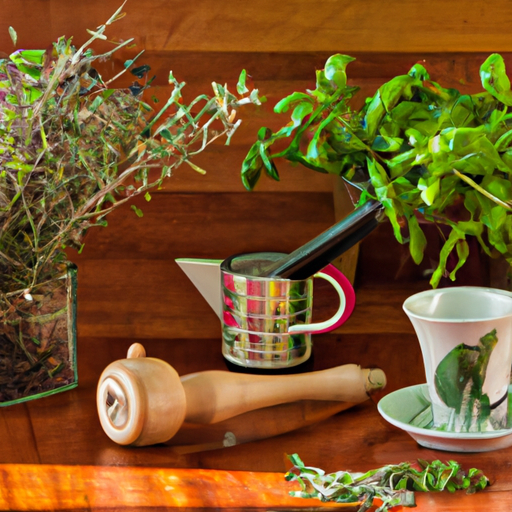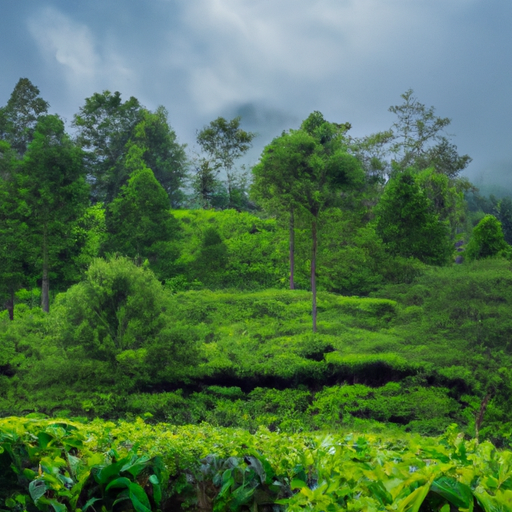Green Tea
10 Essential Facts on How to Store Green Tea Right
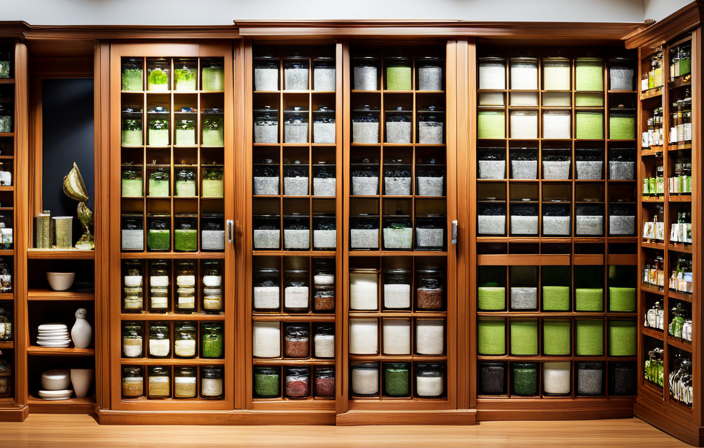
As a tea enthusiast, I’ve discovered the secrets to storing green tea properly.
In this article, I’ll share with you 10 essential facts that will ensure your green tea stays fresh and flavorful.
From the right temperature and humidity levels to choosing the perfect storage container, I’ll guide you through the dos and don’ts of green tea storage.
Get ready to savor every sip of your favorite brew with these expert tips and techniques.
Let’s dive in!
Key Takeaways
- Storing green tea in a cool, dry place is crucial to maintain its quality and flavor.
- UV rays from sunlight can break down beneficial compounds in green tea, causing it to lose freshness.
- Airtight containers help minimize oxygen exposure and extend the shelf life of green tea.
- Proper UV protection, such as storing green tea in UV-blocking containers or a cool, dark place, helps preserve its integrity.
The Role of Temperature in Green Tea Storage
I’ve learned that the temperature plays a crucial role in storing green tea. To maintain its quality and flavor, it’s important to store green tea in a cool, dry place away from direct sunlight. Heat can accelerate the oxidation process and lead to the deterioration of the tea’s taste.
Ideally, green tea should be stored at a temperature between 35°F and 40°F (2°C and 4°C). It’s also essential to protect green tea from light exposure, as UV rays can break down the tea’s beneficial compounds and cause it to lose its freshness.
Additionally, oxygen can have a negative impact on green tea storage. It’s advisable to store the tea in airtight containers to minimize oxygen exposure and extend its shelf life.
Understanding the Impact of Humidity on Green Tea
Humidity can significantly affect the quality and flavor of green tea, so it’s important to understand its impact on storage and brewing.
The impact of moisture on green tea is twofold. Firstly, when exposed to high humidity, green tea leaves can absorb moisture, leading to a loss of flavor and aroma. This is because the moisture alters the chemical composition of the tea, resulting in a dull and stale taste.
Secondly, excessive moisture can create an ideal environment for mold growth. Mold not only ruins the tea leaves but also poses health risks if consumed. To prevent mold growth, it’s crucial to store green tea in a cool, dry place, away from direct sunlight and moisture.
Using airtight containers or resealable bags will help maintain the tea’s freshness and prevent any unwanted moisture from seeping in.
Choosing the Right Storage Container for Green Tea
I prefer using airtight glass containers, as they help preserve the freshness and flavor of green tea. When choosing the right storage container for green tea, it’s important to consider factors that can affect its quality, such as maintaining proper temperature and protecting it from sunlight. Airtight glass containers are ideal because they prevent air from entering, ensuring that the tea remains fresh and free from moisture. Additionally, glass containers do not absorb odors or flavors, allowing the tea to maintain its original taste. To further illustrate the benefits of using airtight glass containers, here’s a comparison table:
| Storage Container Type | Benefits |
|---|---|
| Airtight Glass Containers | Preserve freshness and flavor, prevent air and moisture from entering, do not absorb odors or flavors |
| Plastic Containers | Lightweight and portable, but may absorb odors and flavors |
| Metal Containers | Durable and long-lasting, but may affect taste and flavor |
When it comes to storing green tea, it’s not just about choosing the right container; protecting it from sunlight is equally important. Sunlight can degrade the quality of green tea and cause it to lose its beneficial properties. In the next section, we will discuss the importance of UV protection for green tea and how it can be achieved.
The Importance of UV Protection for Green Tea
UV protection is crucial for green tea due to sunlight’s detrimental effects on its quality. Exposure to UV rays can cause oxidation and degradation of the tea leaves, resulting in a loss of flavor and aroma.
To preserve the integrity of green tea, it’s essential to store it in UV-blocking containers or in a cool, dark place away from direct sunlight.
Sunlight’s Effect on Tea
Brewing my green tea in direct sunlight exposes it to harmful rays, affecting its flavor and quality. As someone who values the perfect cup of tea, I understand the importance of protecting my tea leaves from the damaging effects of sunlight.
Here are four essential facts about the effect of sunlight on tea and the importance of UV protection:
-
Oxidation: Sunlight accelerates the oxidation process in tea leaves, leading to a loss of freshness and flavor.
-
Nutrient degradation: UV rays can degrade the nutrients present in tea, such as antioxidants, reducing their health benefits.
-
Bitterness: Exposure to sunlight can increase the bitterness of tea, making it less enjoyable to drink.
-
Aroma preservation: Proper UV protection helps preserve the delicate aromas of tea, ensuring a more aromatic and flavorful brew.
Preserving Tea Quality
Storing green tea in airtight containers is essential for preserving its quality and preventing flavor degradation. By maintaining temperature control and using proper packaging, you can ensure that your green tea stays fresh and flavorful for longer periods of time. Here are some key factors to consider when storing green tea:
| Temperature Control | Proper Packaging |
|---|---|
| Keep tea away from direct sunlight and extreme temperatures. | Store tea in airtight containers to prevent exposure to air and moisture. |
| Optimal storage temperature is around 70°F (21°C) to 80°F (27°C). | Use opaque containers to block out light and maintain tea’s natural color. |
| Avoid storing tea near strong odors or spices. | Consider vacuum-sealed packaging for long-term storage. |
Uv-Blocking Storage Methods
I always make sure to shield my green tea from harmful UV rays by using opaque containers and keeping it away from direct sunlight. UV rays can degrade the quality and flavor of green tea, so it’s important to protect it.
Here are some tips on UV-blocking storage methods for green tea:
-
UV Blocking Storage Bags: Consider using specially designed UV-blocking storage bags to keep your green tea fresh and protected from harmful rays.
-
Opaque Containers: Opt for opaque containers, such as tin cans or ceramic jars, to store your green tea. These containers block out light and help preserve the tea’s freshness.
-
Glass Jars: If you prefer glass containers, choose dark-colored glass jars that can effectively block UV rays.
-
Proper Placement: Store your green tea in a cool, dry place away from direct sunlight and heat sources to further protect it.
By following these UV-blocking storage methods, you can ensure that your green tea remains fresh and flavorful for longer periods.
Now, let’s move on to the next topic: properly sealing green tea to preserve freshness.
Properly Sealing Green Tea to Preserve Freshness
To keep my green tea fresh, I always make sure to seal it properly. Proper sealing is essential for preserving the flavor and aroma of the tea. When it comes to green tea, it is crucial to protect it from exposure to air, moisture, and light. These elements can degrade the quality of the tea and lead to a loss of flavor. To help you understand the importance of sealing your green tea, here is a table highlighting the effects of improper storage on the tea’s flavor:
| Improper Storage | Effects on Tea’s Flavor |
|---|---|
| Exposed to air | Becomes stale and loses freshness |
| Exposed to moisture | Develops a musty or damp taste |
| Exposed to light | Loses its delicate flavor and color |
How to Store Loose Leaf Green Tea
I’ve found that using an airtight container is the best way to store loose leaf green tea and maintain its freshness. Here are four essential tips for storing green tea leaves:
-
Choose the right container: Opt for a container made of glass or ceramic, as these materials don’t absorb odors or affect the flavor of the tea.
-
Keep it away from light: Green tea leaves are sensitive to light and can lose their freshness when exposed to sunlight. Store them in a dark place or use an opaque container.
-
Maintain a cool and dry environment: Moisture and heat can accelerate the degradation of green tea leaves. Store them in a cool and dry place, away from the stove or any other heat source.
-
Avoid air exposure: Air can cause the tea leaves to oxidize and lose their flavor. Make sure the container is airtight to preserve the freshness of the green tea.
By following these tips, you can ensure that your loose leaf green tea stays fresh and flavorful for a longer period of time.
Now, let’s move on to the next section about storing green tea bags: tips and tricks.
Storing Green Tea Bags: Tips and Tricks
One can maximize the shelf life of green tea bags by storing them in a cool, dry place. Properly storing green tea bags not only extends their shelf life but also preserves their flavor and health benefits. Exposure to heat, light, and moisture can degrade the tea leaves and result in a loss of flavor and potency. By keeping green tea bags in a cool, dry place, you can ensure that they remain fresh and retain their beneficial properties.
When it comes to green tea bags, choosing the best brands is crucial. Look for reputable brands that use high-quality tea leaves and have a good reputation for their products.
Now, let’s delve into the ideal shelf life of green tea and how to determine if it’s still good to use.
The Ideal Shelf Life of Green Tea
I can’t believe how long green tea can stay fresh in its packaging! It’s truly amazing how shelf life can be extended with proper storage techniques. Here are some essential facts on how to store green tea right:
-
Optimal Shelf Life: Green tea can last up to 18 months if stored correctly. This allows you to enjoy its freshness and flavor for a significant period.
-
Airtight Containers: To maintain freshness, store green tea in airtight containers, away from light, heat, and moisture. This helps prevent oxidation and the loss of flavor.
-
Ideal Storage Temperature: Green tea is best stored between 35-50°F (2-10°C). Avoid extreme temperature fluctuations, as they can degrade the tea’s quality.
-
Avoid Strong Odors: Green tea easily absorbs odors, so keep it away from strong-smelling items in your pantry.
Avoiding Common Mistakes in Green Tea Storage
To ensure optimal freshness, it’s crucial to store green tea away from direct sunlight and in a cool, dry place. Proper storage is key to maintaining the delicate flavors and health benefits of this beloved beverage. Let’s discuss some common storage mistakes and the best practices for green tea storage.
| Common Storage Mistakes | Best Practices for Green Tea Storage |
|---|---|
| Exposing tea to sunlight | Store green tea in a dark, opaque container to protect it from harmful UV rays. |
| Storing near strong odors | Keep green tea away from spices, herbs, or any strong-smelling substances to prevent flavor contamination. |
| Storing in a humid environment | Moisture can degrade the quality of green tea, so store it in a cool and dry place to maintain its freshness. |
| Not sealing the container properly | Air exposure can cause oxidation, so ensure that your green tea is stored in an airtight container. |
| Storing for too long | Green tea should be consumed within 6-12 months for the best flavor. Avoid hoarding and buy in smaller quantities to maintain freshness. |
Reviving Stale Green Tea: Expert Tips and Techniques
As an expert in green tea, I’ve discovered some effective techniques for reviving stale tea.
First, try placing the tea leaves in a sealed container with a slice of citrus peel for a few hours to infuse them with fresh aromas.
Another method is to lightly toast the leaves in a pan to restore their flavor.
Stale Tea Revival Techniques
There’s a technique I’ve learned for reviving stale tea that involves adding a slice of lemon and a sprinkle of sugar. However, it’s important to note that prevention is always better than revival when it comes to tea.
Here are some essential tips for storing tea and preserving its quality:
-
Keep it airtight: Stale tea is often the result of exposure to air, which can cause it to lose its flavor and aroma. Store your tea in airtight containers to protect it from moisture and oxygen.
-
Avoid heat and light: Tea is sensitive to heat and light, which can accelerate its deterioration. Store your tea in a cool, dark place, away from direct sunlight or heat sources.
-
Separate flavors: Different teas have distinct flavors and aromas. To prevent cross-contamination and preserve each tea’s unique qualities, store them separately in labeled containers.
-
Use it within a year: Tea is best enjoyed fresh, so try to consume it within a year of purchase. After that, its quality may start to decline.
Expert Tips for Freshness
I’ve discovered that adding a pinch of baking soda and a splash of hot water is an effective way to revive stale green tea, but it’s crucial to follow expert tips for freshness to maintain its quality.
Green tea is delicate and can easily lose its flavor and aroma if not stored properly. To ensure the best taste, it’s important to store green tea in an airtight container, away from light, heat, and moisture. Expert advice suggests keeping it in a cool, dark place, such as a pantry or cupboard.
Additionally, using the tea within a year of purchase is recommended for optimal freshness.
These best practices will help you serve a delicious cup of green tea, filled with all its natural goodness.
Proper Green Tea Storage
Storing green tea properly is essential for preserving its freshness and flavor. As someone who loves tea and wants to serve others the best cup possible, I’ve gathered some helpful green tea storage tips to prevent flavor loss. Here are four key points to consider:
-
Keep it airtight: To maintain freshness, store green tea in airtight containers, such as glass jars or resealable bags. This will help prevent exposure to moisture, air, and other odors that can degrade the flavor.
-
Avoid light and heat: Green tea is sensitive to light and heat, so store it in a cool, dark place away from direct sunlight and heat sources. This will help preserve its delicate taste and aroma.
-
Minimize air exposure: Every time you open the container, air comes in contact with the tea, causing oxidation and flavor loss. To prevent this, divide your green tea into smaller portions and only open one at a time.
-
Don’t store near strong odors: Green tea easily absorbs odors from its surroundings. Keep it away from strong-smelling foods or spices to maintain its pure and natural flavor.
Frequently Asked Questions
How Long Can Green Tea Be Stored Before It Goes Bad?
I can tell if green tea has gone bad by checking for any odd smells or tastes. To store loose leaf green tea properly, I recommend keeping it in an airtight container away from heat and moisture.
Can Green Tea Be Stored in the Refrigerator?
Storing green tea in the refrigerator can affect its taste and quality. It is important to properly store loose green tea leaves to maintain freshness and flavor.
Is It Better to Store Green Tea in Airtight Bags or Containers?
It’s important to store green tea properly to maintain its freshness and flavor. When it comes to airtight bags vs. containers, I’ve found that airtight bags are better for preserving the tea’s quality.
Does the Type of Water Used to Brew Green Tea Affect Its Storage Requirements?
The type of water used to brew green tea can impact its storage requirements. Water quality can affect the taste and aroma of the tea. It’s important to use clean, filtered water for the best results. Alternative storage methods can also be considered.
Can Green Tea Be Stored Alongside Other Types of Tea Without Affecting Its Flavor?
Storing green tea with herbal tea won’t affect its flavor, but it’s best to keep them separate to preserve their individual characteristics. Avoid storing green tea in metal containers as it can alter its taste.
Conclusion
In the world of green tea storage, knowledge is key. By understanding the role of temperature, humidity, and UV protection, as well as choosing the right storage container and sealing methods, you can ensure the freshness and quality of your green tea.
Avoid common mistakes and learn how to revive stale tea with expert tips and techniques.
With these essential facts, you can savor every sip of your perfectly stored green tea like a breath of fresh air on a sunny day.
Green Tea
How Can You Prepare the Perfect Cup of Green Tea?

Being a passionate tea enthusiast, I am always on the lookout for methods to brew the ideal cup of green tea.
In this article, I will share my knowledge and insights on the importance of water temperature, proper steeping time, and choosing high-quality tea leaves.
By avoiding boiling water and opting for loose tea leaves, you can enhance the flavor and reap the numerous health benefits of green tea.
Join me on this comprehensive journey to making the best green tea you’ve ever tasted.
Key Takeaways
- Adjust water temperature to recommended range for extracting flavors and nutrients.
- Steeping time determines taste and quality of green tea.
- Choosing high-quality tea leaves is important for a flavorful cup of green tea.
- Avoid boiling water for green tea to prevent bitterness.
Importance of Water Temperature
I always make sure to adjust the water temperature to the recommended range when brewing my green tea because it’s important for extracting the right flavors and nutrients. Water temperature control is a crucial aspect of brewing techniques that can greatly impact the taste and quality of your tea.
Green tea is delicate, and using water that’s too hot can result in a bitter taste. On the other hand, if the water isn’t hot enough, you may not be able to fully extract the desired flavors from the tea leaves. To achieve the perfect cup of green tea, it’s recommended to use water that’s around 175 to 185 degrees Fahrenheit. This temperature range allows the tea leaves to unfurl and release their flavors without being scorched.
Now that we’ve discussed the importance of water temperature, let’s move on to the next crucial factor in preparing the perfect cup of green tea: the proper steeping time.
Proper Steeping Time for Green Tea
The recommended steeping time for green tea is around 2 to 3 minutes, allowing the flavors to fully develop without becoming bitter.
When it comes to preparing the perfect cup of green tea, the optimal brewing time is crucial. Green tea leaves are delicate and require careful attention to ensure their flavors are properly extracted. Steeping for too long can result in a bitter taste, while steeping for too short a time can leave the tea lacking in flavor.
To achieve the best results, it’s important to follow proper tea brewing techniques. This includes using water at the right temperature, around 175°F (80°C), and steeping the leaves for the recommended time.
Choosing High-Quality Tea Leaves
When choosing high-quality tea leaves, it’s important to consider their origin and freshness, as well as the processing methods used. These factors greatly influence the taste and aroma of the final cup of tea. To help you make an informed choice, here is a table highlighting some popular loose leaf options for green tea:
| Tea Type | Origin | Processing Method |
|---|---|---|
| Sencha | Japan | Steamed |
| Dragonwell | China | Pan-fired |
| Matcha | Japan | Stone-ground |
| Gunpowder | China | Rolled |
| Gyokuro | Japan | Shade-grown |
Each of these teas has its own unique profile, so it’s worth experimenting to find your preferred taste. Once you have chosen your tea, it’s important to steep it for the ideal amount of time. Green tea generally requires a shorter steeping time of 1-3 minutes to avoid bitterness. Now, let’s move on to the next section about avoiding boiling water for green tea.
Avoiding Boiling Water for Green Tea
When preparing green tea, it’s important to avoid using boiling water as it can scorch the delicate leaves and result in a bitter taste.
Instead, water around 175°F (80°C) is ideal for green tea, allowing the flavors to fully develop without overpowering the delicate nuances.
Ideal Water Temperature
I personally find that slightly cooler water temperature enhances the flavor of green tea. When it comes to brewing the perfect cup, the ideal water temperature plays a crucial role. Here are a few key points to keep in mind:
-
Optimal temperature: Green tea is delicate, and using water that’s too hot can result in a bitter taste. The ideal water temperature for green tea is around 175°F (80°C).
-
Avoid boiling water: Boiling water can scorch the delicate tea leaves, resulting in a less flavorful brew. By using slightly cooler water, you can extract the delicate flavors without overpowering the tea.
-
Steeping time: To achieve the perfect balance of flavor, it’s important to steep green tea for the proper amount of time. Typically, steeping for 2-3 minutes is recommended to bring out the unique flavors and aromas.
-
Experimentation: Everyone’s taste preferences are different, so feel free to experiment with water temperatures and steeping times to find the perfect combination that suits your palate.
By understanding the importance of water temperature and steeping time, you can unlock the full potential of your green tea.
Now, let’s delve into the next section and explore some recommended steeping times.
Steeping Time Recommendations
To bring out the unique flavors and aromas of green tea, it’s crucial to steep it for the recommended 2-3 minutes, allowing the delicate leaves to infuse fully. Steeping time plays a significant role in determining the taste and quality of your green tea.
Different steeping techniques can result in various flavor variations. For a milder taste, steeping for 2 minutes is ideal, while those who enjoy a stronger brew can extend the time to 3 minutes. These recommended steeping times allow the tea leaves to release their natural flavors and create a well-balanced cup of green tea. However, it’s important to note that steeping for too long can lead to a bitter taste.
Now, let’s move on to the importance of water quality in achieving the perfect cup of green tea.
Importance of Water Quality
To achieve the perfect cup of green tea, it’s crucial that I avoid boiling the water, as it can affect the water quality and ultimately impact the taste of my tea. Here are four reasons why water quality is important in brewing the perfect cup of green tea:
-
Water Filtration: Using filtered water helps remove impurities and chlorine, resulting in a purer taste.
-
Mineral Content: The mineral content in water can enhance the flavor and aroma of green tea, making it more enjoyable to drink.
-
Temperature Control: Boiling water can scorch the delicate leaves of green tea, leading to a bitter taste. By using water that’s around 175°F (79°C), I can ensure a smoother and more balanced flavor.
-
Consistency: Maintaining consistent water quality ensures that each cup of green tea I brew will have the same delightful taste.
With the importance of water quality in mind, let’s now explore the benefits of using loose tea leaves.
Benefits of Using Loose Tea Leaves
I love using loose tea leaves because they offer a more enhanced and complex flavor profile compared to tea bags.
Not only do loose tea leaves provide a richer and more satisfying taste, but they also tend to be healthier since they’re less processed and contain more antioxidants.
Additionally, using loose tea leaves is a more environmentally friendly option as it reduces packaging waste.
Enhanced Flavor Profile
Using loose tea leaves in my green tea brewing process has resulted in an enhanced flavor profile. The rich and complex taste of loose tea leaves is far superior to the convenience of tea bags. Here are four reasons why loose tea leaves can elevate your green tea experience:
-
Enhanced Aroma: Loose tea leaves release a more fragrant and enticing aroma compared to tea bags. The aroma adds an extra layer of enjoyment to the drinking experience.
-
Fresher Taste: Loose tea leaves retain their freshness better than tea bags. This freshness translates into a more vibrant and flavorful cup of green tea.
-
Greater Control: Brewing techniques can be customized with loose tea leaves. You can adjust the steeping time and water temperature to extract the desired flavors and avoid bitterness.
-
Higher Quality: Loose tea leaves often consist of higher-quality tea leaves, offering a more refined and nuanced taste compared to tea bags. This attention to quality enhances the overall flavor profile of your green tea.
Healthier Than Tea Bags
Drinking green tea made with loose tea leaves isn’t only tastier but also healthier than using tea bags. Loose tea leaves contain more antioxidants and polyphenols, which are beneficial for our health. When brewing loose tea leaves, the hot water can fully extract the nutrients, resulting in a richer and more flavorful cup of tea.
Additionally, loose tea leaves allow for customization and experimentation with brewing techniques, such as adjusting the water temperature and steeping time, to achieve the desired flavor profile. This versatility ensures that we can fully enjoy the health benefits of green tea while savoring its delicious taste.
More Environmentally Friendly
Can we reduce our environmental impact by switching to loose tea leaves instead of tea bags?
-
Less Packaging Waste: Loose tea leaves often come in eco-friendly packaging, such as recyclable paper or reusable tins, reducing the amount of plastic waste generated compared to tea bags.
-
Sustainable Tea Farming: Many loose tea leaves are sourced from sustainable tea farms that prioritize environmental conservation and ethical practices. By choosing loose tea, you support these farms and contribute to a more sustainable tea industry.
-
Better Taste and Quality: Loose tea leaves offer a fresher and richer flavor compared to tea bags, as they’re less processed and contain whole leaves. This enhances the overall tea drinking experience and allows you to fully enjoy the natural flavors and aromas.
-
Customizable Brewing: With loose tea leaves, you have more control over the strength and flavor of your tea. You can adjust the amount of leaves and steeping time according to your preferences, resulting in a cup of tea tailored to your liking.
Comprehensive Guide to Making Green Tea
I’ve found that following a six-step process is the key to making a truly delicious cup of green tea.
-
The first step is to choose the right brewing method. For green tea, it’s best to use water that’s around 175°F to 185°F, as boiling water can make the tea taste bitter.
-
The second step is to measure the tea leaves correctly, using about one teaspoon per cup of water.
-
Next, understanding tea oxidation is important. Green tea is unoxidized, which gives it a fresh and grassy flavor.
-
The fourth step is to steep the tea for about 2-3 minutes to extract the flavors without overbrewing.
-
The fifth step is to strain the tea to remove any leaves or debris.
-
Finally, serve the tea hot and enjoy its refreshing taste.
Frequently Asked Questions
What Are the Health Benefits of Drinking Green Tea?
Drinking green tea can have numerous health benefits, including weight loss and cancer prevention. It is a natural and healthy beverage that can be enjoyed daily to support overall well-being.
How Should Green Tea Be Stored to Maintain Its Freshness?
To maintain the freshness of green tea, store it in an airtight container away from light, heat, and moisture. This will help preserve its flavor and prevent oxidation, ensuring a perfect cup every time.
Can Green Tea Be Consumed With Milk or Sweeteners?
Green tea can be consumed with milk or sweeteners, such as honey, to enhance its flavor. It can also be used to make a delicious green tea latte, which combines the benefits of tea and milk.
Can Green Tea Be Reheated or Consumed Cold?
Reheating green tea alters its flavor and can make it bitter. It is best to drink green tea freshly brewed, but if you want to consume it cold, simply refrigerate it.
Are There Any Specific Recommendations for Brewing Green Tea for Medicinal Purposes?
When brewing green tea for medicinal purposes, it’s important to follow specific techniques and dosage requirements. Achieving the perfect cup requires precision and attention to detail. Let me guide you through the process.
Conclusion
In the world of tea, the perfect cup of green tea is a delicate balance of temperature, steeping time, and quality. By understanding the importance of water temperature, using high-quality loose tea leaves, and avoiding boiling water, you can create a truly exceptional cup of green tea.
Remember, tea-making is an art that requires patience and attention to detail. So, take the time to master the craft and savor the soothing flavors and numerous health benefits that green tea has to offer.
Green Tea
What Factors Contribute to the Sometimes Bitter Taste of Green Tea?

I have always been curious as a tea lover, why does green tea sometimes taste bitter?
After conducting extensive research, I’ve discovered several key factors that contribute to this unique flavor.
From the duration of steeping to the quality and freshness of the leaves, each element plays a role in the bitterness of green tea.
In this article, I will delve into these factors and share some tips to enhance the flavor of your green tea experience.
So grab a cup and let’s explore together!
Key Takeaways
- Steeping time: Longer steeping time increases bitterness, so it is important to follow the recommended steeping duration provided by the tea manufacturer.
- Water temperature: Too hot water leads to a bitter taste, while too cool water results in a weak and lackluster taste. Finding the optimal water temperature between 175 to 185 degrees Fahrenheit is key to avoiding bitterness.
- Quantity and quality of tea leaves: Using excessive amounts of tea leaves can lead to bitterness, so it is important to follow the recommended tea-to-water ratio. Higher quality leaves tend to have a smoother and less bitter taste.
- Freshness of tea leaves: Stale tea leaves result in a dull and bitter brew, while freshly harvested tea leaves retain their natural flavors and delicate characteristics. Choosing green tea made from fresh leaves ensures the best quality and taste.
Steeping Duration and Bitterness
I’ve noticed that the longer I steep my green tea, the stronger the bitterness becomes. The steeping technique and brewing equipment play a crucial role in determining the taste of your green tea. To achieve a perfectly balanced cup, it’s important to understand the optimal steeping duration and select the right brewing equipment.
When steeping green tea, it’s recommended to follow the instructions provided by the tea manufacturer. Typically, green tea requires a shorter steeping time compared to other types of tea. Oversteeping can lead to excessive bitterness. To avoid this, set a timer and remove the tea leaves or tea bag promptly after the recommended time.
The type of brewing equipment you use also affects the taste. For example, using a teapot with a built-in infuser allows the tea leaves to expand and release their flavors more effectively. This ensures a better extraction and minimizes the risk of bitterness caused by oversteeping.
Impact of Water Temperature on Green Tea Taste
When it comes to brewing green tea, the water temperature plays a crucial role in determining its taste. The optimal water temperature for brewing green tea is typically around 175 to 185 degrees Fahrenheit.
If the water is too hot, it can lead to a bitter and astringent taste, overpowering the delicate flavors of the tea leaves.
However, if the water is too cool, the tea may end up tasting weak and lackluster.
Finding the perfect balance in water temperature is key to achieving a well-balanced and enjoyable cup of green tea.
Optimal Water Temperature
The optimal water temperature for brewing green tea is 175 degrees Fahrenheit. This temperature ensures that the tea leaves release their flavors without becoming bitter. When the water is too hot, it can scorch the leaves and result in a bitter taste. On the other hand, if the water is too cool, the tea won’t steep properly and the flavors will be weak. To emphasize the importance of water temperature, I have created a table below that outlines the optimal brewing techniques for green tea:
| Water Temperature | Steeping Time | Resulting Flavor |
|---|---|---|
| 175°F | 2 minutes | Balanced |
| 160°F | 3 minutes | Subtle |
| 185°F | 1 minute | Strong |
Bitterness Due to Overheating
Experiencing bitterness due to overheating is frustrating, but by adjusting the water temperature and using proper brewing techniques, you can avoid this issue and enjoy a perfectly balanced cup of green tea.
Overheating prevention is crucial in preserving the delicate flavors of green tea. When water is too hot, it can scorch the leaves and release unwanted bitter compounds. To prevent overheating, it’s recommended to use water that’s around 175°F (80°C) for green tea. This temperature allows the tea leaves to steep gently, preserving their natural flavors and preventing bitterness.
It’s also important to pay attention to the steeping time, as leaving the tea leaves in hot water for too long can also result in a bitter taste.
Transitioning into the next section, another factor that can contribute to bitterness is the quantity of tea leaves used.
Quantity of Tea Leaves Used and Bitterness
I can taste the bitterness when I use too many tea leaves. The quantity of tea leaves used in brewing green tea can greatly impact its flavor. When we use an excessive amount of leaves, the resulting brew becomes overpoweringly bitter. To avoid this, it’s important to follow the recommended guidelines for tea-to-water ratio.
Generally, a teaspoon of green tea leaves per cup of water is a good starting point. However, personal preferences may vary, so feel free to adjust accordingly. Additionally, brewing methods can also affect the bitterness of green tea. Steeping the leaves for too long or using water that’s too hot can extract more tannins and lead to a bitter taste.
Lastly, it’s worth noting that additives like sugar or milk can also influence the flavor profile of green tea. While they may help balance the bitterness, they can alter the tea’s natural taste. Therefore, it’s best to explore different brewing techniques and find the perfect balance to enjoy a delightful cup of green tea.
Quality of Tea Leaves and Bitterness
When it comes to the bitterness of green tea, the quality of the tea leaves plays a significant role. Higher quality leaves tend to have a smoother and less bitter taste compared to lower quality leaves. This is because the processing methods used for high quality leaves are more meticulous, resulting in a tea with a more delicate and balanced flavor.
Additionally, the freshness of the leaves can also affect the bitterness, as older leaves are more likely to develop a bitter taste.
Leaf Oxidation and Bitterness
Although leaf oxidation plays a significant role in the bitterness of tea, other factors such as steeping time and water temperature also contribute to the overall taste.
When it comes to leaf quality, the freshness and processing of the leaves can greatly affect the bitterness. Fresher leaves tend to have a milder taste, while older leaves may be more bitter.
Additionally, the brewing technique used can impact the bitterness of the tea. Steeping the leaves for too long or using water that’s too hot can result in a more bitter taste. On the other hand, steeping for a shorter period and using cooler water can help reduce the bitterness.
Brewing Temperature and Bitterness
To achieve the perfect balance of flavors in my green tea, I must carefully consider the brewing temperature and the quality of the tea leaves. Optimal brewing involves temperature control, as different temperatures can significantly affect the taste profile of green tea. Green tea is best brewed at a lower temperature, around 175°F (80°C), to avoid extracting excessive bitterness from the leaves. This temperature allows the delicate flavors to unfold, resulting in a smoother and more enjoyable cup. However, it’s essential to note that different types of green tea may require slight temperature adjustments. By controlling the brewing temperature, I can ensure that my green tea retains its delicate flavors while minimizing any potential bitterness.
Now, let’s move on to the next consideration: steeping time and its impact on bitterness.
Steeping Time and Bitterness
I find that a shorter steeping time of one minute results in a less bitter cup of green tea. When it comes to brewing green tea, managing the steeping time is crucial in achieving the desired flavor profile.
Here are some key points to consider for steeping time management and reducing bitterness:
-
The longer the tea leaves steep, the more bitter the flavor becomes. Shortening the steeping time can help to minimize bitterness.
-
Green tea leaves are delicate and can easily become over-steeped, resulting in a bitter taste. It’s important to monitor the steeping time closely to avoid this.
-
Experimenting with different steeping times can help you find the perfect balance between flavor and bitterness. Start with a shorter steeping time and gradually increase if desired.
Freshness of Tea Leaves and Its Influence on Taste
I’ve noticed that the taste of my green tea is significantly affected by the freshness of the tea leaves. The influence of storage and the impact of processing play a crucial role in determining the quality and flavor of green tea.
When tea leaves are stored for a long time, they can become stale, losing their vibrant taste and aroma. This can result in a dull and bitter brew.
On the other hand, freshly harvested tea leaves undergo minimal processing, allowing them to retain their natural flavors and delicate characteristics. These leaves are rich in antioxidants and have a smoother, more pleasant taste.
To ensure the best quality, it’s important to choose green tea made from fresh leaves and store it properly to maintain its freshness. By doing so, you can enjoy a truly delightful cup of green tea every time.
Other Factors Affecting the Bitterness of Green Tea
The steeping time of green tea can greatly affect its bitterness. When steeped for too long, the tea leaves release more tannins, which contribute to a bitter taste. On the other hand, steeping for too short a time may result in a weak and bland flavor.
In addition to steeping time, there are other factors that can affect the bitterness of green tea:
-
Leaf quality: The quality of the tea leaves used can greatly impact the taste of the brewed tea. Higher quality leaves tend to have a smoother and less bitter flavor compared to lower quality leaves.
-
Water temperature: Brewing green tea at a high temperature can extract more bitterness from the leaves. It’s recommended to use water that’s around 175°F (80°C) to prevent excessive bitterness.
-
Flavor enhancement techniques: Some people add a touch of sweetness, such as honey or sugar, to balance out the bitterness of green tea. Others may experiment with different flavorings, such as lemon or mint, to enhance the overall taste.
Tips to Enhance the Flavor of Green Tea
Adding a squeeze of fresh lemon to my green tea enhances the flavor and gives it a refreshing twist.
But what’re some other ways to reduce the bitterness of green tea and make it more enjoyable?
One effective method is to adjust the brewing time and water temperature. Steeping green tea for a shorter duration, around 1-2 minutes, can help reduce bitterness. Similarly, using slightly cooler water, around 170-180°F (77-82°C), instead of boiling water, can also result in a smoother, less bitter taste.
Additionally, flavor pairing suggestions can help balance the bitterness of green tea. Adding a teaspoon of honey or a splash of milk can add sweetness and creaminess, counteracting the bitterness. Another option is to infuse the tea with fresh fruits like berries or citrus slices, which can add a natural sweetness and complement the green tea flavor.
Frequently Asked Questions
What Is the Ideal Steeping Duration for Green Tea to Avoid Bitterness?
The ideal steeping duration for green tea to avoid bitterness is around 2-3 minutes. By following proper steeping techniques, such as using water at the right temperature and not over-brewing, you can achieve a smoother flavor.
How Does Water Temperature Affect the Taste of Green Tea?
Water temperature plays a crucial role in the taste of green tea. Different temperatures can bring out different flavors and intensities. It’s important to find the right balance to avoid bitterness and enhance the tea’s natural qualities.
Does the Quantity of Tea Leaves Used Affect the Bitterness of Green Tea?
Using the ideal steeping techniques and different brewing methods, I can confidently say that the quantity of tea leaves used does contribute to the sometimes bitter taste of green tea.
How Does the Quality of Tea Leaves Contribute to the Bitterness of Green Tea?
The quality of tea leaves can greatly impact the bitterness of green tea. Factors like the ideal water temperature and steeping time play a crucial role in extracting the flavors from the leaves without releasing excessive bitterness.
How Does the Freshness of Tea Leaves Influence the Taste of Green Tea?
Freshness impact on green tea flavor profile is significant. For example, when leaves are harvested too late, they become bitter. The longer they sit, the more bitter the tea tastes.
Conclusion
In conclusion, the bitterness of green tea can be influenced by several factors.
Steeping duration, water temperature, quantity of tea leaves, quality and freshness of the leaves all play a role in determining the taste.
To enhance the flavor of green tea, it’s important to pay attention to these factors and adjust them accordingly.
By doing so, one can enjoy a more balanced and enjoyable cup of green tea.
Green Tea
Become a Connoisseur: Mastering the Art of Buying Green Tea
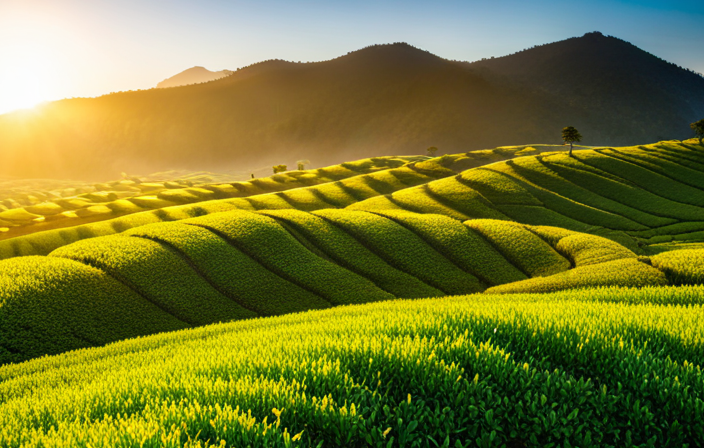
As someone who adores tea, I’ve grown to value the process of purchasing green tea. The quest for the ideal cup is an adventure filled with enthusiasm and exploration. From establishing a budget to figuring out what I like, I’ve realized paying attention to the specifics is crucial.
Researching brands, checking ingredient lists, and examining dates all play a part in finding the highest quality tea.
So join me as we embark on this connoisseur’s quest and master the art of buying green tea.
Key Takeaways
- Plan expenses carefully and consider the cost of different green tea options to stay within budget.
- Explore different green tea varieties and their flavor profiles to find one that suits personal taste preferences.
- Research different green tea brands by attending tastings, reading customer reviews, and considering certifications or awards.
- Check the ingredients, freshness, and packaging of green tea to ensure it is of high quality and free from harmful additives.
Setting a Budget
I need to carefully plan my expenses in order to stay within my budget for buying green tea.
As a connoisseur, determining the quality of the tea is of utmost importance to me. I believe that the taste and aroma of green tea can transport us to a place of tranquility and well-being. To ensure I’m getting the best quality, I explore various options available in the market. I look for tea leaves that are vibrant in color, with a fresh and grassy scent. I prefer loose leaf tea over tea bags, as it allows the leaves to fully unfurl and release their flavors.
Determining Preferences
Determining my preferences when it comes to green tea is essential in finding the perfect blend for my taste. As an avid tea lover, I take great pleasure in exploring different varieties and understanding their unique flavor profiles. Each cup of green tea offers a delightful journey of aromas and tastes, allowing me to curate my own personal collection. To help you visualize the vast world of green tea, I have created a table showcasing some popular varieties and their distinct characteristics:
| Variety | Flavor Profile |
|---|---|
| Sencha | Grassy, vegetal |
| Matcha | Rich, umami |
| Dragonwell | Nutty, sweet |
| Genmaicha | Toasted rice, savory |
| Gyokuro | Floral, mellow |
Researching Brands
After exploring different green tea varieties and determining my preferences, I can now delve into researching brands to find the perfect match for my taste.
As a tea enthusiast, I’m always on the lookout for hidden gem brands that offer exceptional quality and unique flavors. One of the best ways to discover these brands is by attending tea tastings. These events not only allow me to sample a wide range of teas, but also learn about the different tea tasting techniques.
From evaluating the aroma and appearance to experiencing the taste and aftertaste, these techniques help me identify the nuances and complexities of each tea.
Armed with this knowledge, I can confidently research and select brands that align with my preferences, ensuring a satisfying tea-drinking experience every time.
Checking Ingredient List
When it comes to buying green tea, checking the ingredient list is an essential step in ensuring the quality and purity of the product. Hidden harmful additives can often be found lurking in teas, especially those that are conventionally grown.
Hidden Harmful Additives
I actively avoid purchasing green tea with hidden harmful additives by carefully checking the ingredient list. As a health-conscious individual, I understand the importance of avoiding chemicals and potential health risks.
Here are four things I always keep in mind when buying green tea:
-
Organic Certification: I look for teas that are certified organic, ensuring they’re free from pesticides and harmful chemicals.
-
Natural Flavorings: I steer clear of teas that contain artificial flavorings, opting for those with natural flavorings instead.
-
No Added Sugars: I prioritize teas that have no added sugars or sweeteners, as excessive sugar intake can lead to various health issues.
-
Transparent Packaging: I prefer teas that come in transparent packaging, allowing me to visually inspect the tea leaves and ensure their quality.
Organic Vs. Conventional Teas?
As a health-conscious individual, I carefully compare the ingredient lists of organic and conventional teas to make an informed decision. When it comes to choosing between organic and conventional teas, the decision can seem daunting. However, understanding the key differences can help you make a choice that aligns with your health goals.
Organic teas are cultivated without the use of synthetic fertilizers, pesticides, or genetically modified organisms (GMOs). They are grown using natural methods that prioritize soil health, biodiversity, and sustainability. On the other hand, conventional teas are often grown using conventional farming practices, which may involve the use of synthetic chemicals and pesticides.
To better understand the differences, let’s take a closer look at the table below:
| Organic Teas | Conventional Teas |
|---|---|
| No synthetic chemicals or pesticides | May contain synthetic chemicals and pesticides |
| Grown in harmony with nature | May have negative environmental impact |
| Rich in antioxidants and beneficial compounds | May have lower nutrient content |
When examining the table, it becomes clear that organic teas offer numerous health benefits compared to conventional teas. The absence of synthetic chemicals and pesticides ensures that they are free from harmful residues, making them a healthier choice for you and the environment. Additionally, organic teas are known to be richer in antioxidants and beneficial compounds, which can support overall well-being.
Now that we have explored the differences between organic and conventional teas, let’s move on to the next section and examine the importance of checking the date of the tea you purchase.
Examining Date
I’m evaluating the expiration date on this green tea to ensure its freshness. As a tea enthusiast, I understand the importance of examining freshness when it comes to enjoying the perfect cup of tea.
Here are a few key things to consider:
- Expiration date: Check the date printed on the packaging to ensure that the tea is still within its optimal freshness period.
- Appearance: Look for vibrant, intact tea leaves that have retained their color and aroma.
- Smell: Take a deep breath and inhale the aroma of the tea. Fresh tea should have a pleasant, fragrant smell.
- Taste: Brew a small sample and taste the tea. Fresh tea should have a clean, crisp flavor that’s free from any stale or bitter notes.
By paying attention to these factors, we can ensure that we’re getting the freshest green tea possible.
Now, let’s move on to the next section and discuss the importance of starting with small amounts.
Starting With Small Amounts
Starting with small amounts of green tea allows you to explore a wide range of flavors and discover what suits your palate.
It’s like embarking on a culinary adventure, where each sip brings a new sensation and a delightful surprise.
Experimenting With Flavors
I love experimenting with flavors by adding small amounts of different ingredients to my dishes. It’s a way for me to explore unique blends and create culinary masterpieces that delight the senses. When it comes to cooking, there are endless possibilities to create new and exciting flavors. Here are a few tips that I’ve learned along the way:
- Mix sweet and savory: Combining ingredients like honey and soy sauce can create a perfect balance of flavors.
- Play with spices: Adding a pinch of cinnamon or a dash of cayenne pepper can elevate the taste of any dish.
- Try different herbs: Experimenting with fresh herbs like basil, cilantro, or rosemary can add a burst of freshness to your meals.
- Don’t forget about acidity: A squeeze of lemon or a splash of vinegar can brighten up the flavors and make them pop.
Understanding different brewing techniques is also important when exploring new flavors. Whether it’s coffee or tea, the way it’s brewed can greatly impact its taste. By experimenting with different brewing methods, such as French press or cold brew, you can unlock a whole new world of flavors.
Benefits of Small Batches
When experimenting with flavors, it’s important to start with small amounts of ingredients, as this allows for better control over the taste and ensures that the final result isn’t overpowering.
This principle applies not only to cooking, but also to other aspects of our lives, such as the benefits of freshness and quality control in the products we consume. Fresh ingredients bring out the best in a dish, enhancing its flavors and nutritional value.
Similarly, quality control ensures that each ingredient meets the highest standards, guaranteeing a consistent and satisfying experience for our customers. By prioritizing freshness and quality control, we can create exceptional culinary delights that leave a lasting impression.
Now, let’s dive deeper into the world of flavors and discuss how to find hidden gems that will elevate our culinary creations to new heights.
Finding Hidden Gems
Although I enjoy experimenting with flavors, finding hidden gems in small amounts has become my new passion. There’s something truly satisfying about discovering a tea that isn’t widely known, yet offers a unique and delightful taste experience. As I delve into the world of tea, I’ve come across some incredible finds that I can’t help but share with others. Here are a few of my recent discoveries:
-
White Peony: This delicate tea has a subtle floral aroma and a smooth, creamy taste. It’s perfect for a calming afternoon break.
-
Dragonwell: Known for its chestnut-like flavor and refreshing grassy notes, Dragonwell is a green tea that’s a true delight to the senses.
-
Jasmine Pearls: These tightly rolled tea leaves unfurl to release a fragrant and soothing aroma. The infusion offers a perfect balance of floral and sweet flavors.
-
Iron Goddess: With its roasted aroma and nutty undertones, Iron Goddess, also known as Tie Guan Yin, is a must-try for oolong enthusiasts.
When it comes to brewing techniques, I find that using lower water temperatures and shorter steeping times allows the flavors to truly shine. It’s all about finding the perfect balance to bring out the best in each tea.
Properly Storing Tea
I’ve learned that storing tea bags in an airtight container can help preserve their freshness for up to six months. Properly storing tea is essential to maintain its flavor and quality. When it comes to green tea, it is particularly important to follow specific storage tips to maximize its taste and health benefits.
Here are some tea storage tips for green tea:
| Temperature | Humidity | Light | Air |
|---|---|---|---|
| Cool | Dry | Dark | Airtight container |
| 65-85°F (18-29°C) | 50-70% | No direct sunlight | Avoid exposure to air |
Green tea is delicate and sensitive to environmental factors. Storing it in a cool and dry place, away from direct sunlight, is crucial. Exposure to light can degrade the tea leaves and affect their taste. It’s also important to keep green tea in an airtight container to prevent air from getting in and causing oxidation.
Frequently Asked Questions
How Do I Choose the Right Brewing Temperature and Time for Green Tea?
Choosing the right brewing temperature and time for green tea is crucial for maximizing flavor and health benefits. It’s a delicate balance that can enhance the tea’s natural flavors and unlock its potential health properties.
Can I Reuse Green Tea Leaves for Multiple Infusions?
Sure! Reusing green tea leaves for multiple infusions is a great way to maximize flavor and health benefits. Adjust brewing temperature and time for each infusion to maintain taste and quality. Loose leaf green tea is ideal, but tea bags work too!
What Are the Health Benefits of Drinking Green Tea?
Drinking green tea has numerous health benefits. It can improve skin health and aid digestion. The antioxidants in green tea help fight free radicals and promote overall wellness. It’s a wonderful beverage to enjoy daily.
Are There Any Specific Green Tea Varieties That Are Better for Weight Loss?
There are specific green tea varieties that can aid in weight loss. Certain varieties, like matcha and sencha, are known for their metabolism-boosting properties. Incorporating these teas into your routine can support your weight loss goals.
What Are the Differences Between Loose Leaf Green Tea and Tea Bags in Terms of Taste and Quality?
Loose leaf green tea and tea bags have distinct differences in taste and quality. Loose leaf offers a more vibrant flavor and higher quality leaves, while tea bags are convenient but may contain lower quality leaves.
Conclusion
In conclusion, becoming a connoisseur of green tea is a journey worth embarking on. By setting a budget, determining your preferences, researching brands, checking ingredient lists, examining dates, and starting with small amounts, you can find the perfect tea that suits your taste and meets your standards.
For example, imagine discovering a small, family-owned tea farm in Japan that uses traditional cultivation methods, resulting in a delicate and vibrant green tea that transports you to the tranquil landscapes of Kyoto with every sip.
The world of green tea awaits, ready to be explored and savored.
-

 Turmeric Tea3 months ago
Turmeric Tea3 months agoWhat Teas Are Low In Oxalates
-
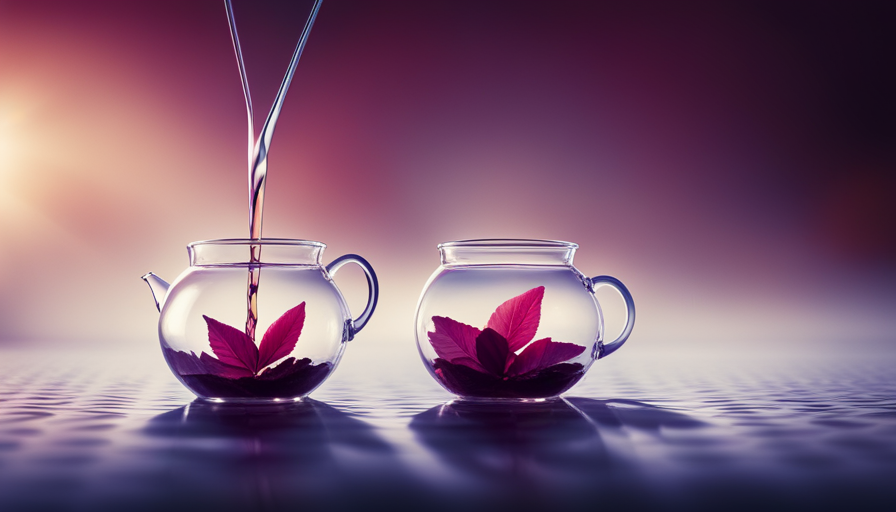
 Turmeric Tea3 months ago
Turmeric Tea3 months agoWhat Teas Have No Tannins
-

 Tea and Philosophy2 months ago
Tea and Philosophy2 months agoLinkBoss Revolutionizes Interlinking Strategy for WordPress Sites
-

 Rooibos Tea2 months ago
Rooibos Tea2 months agoRooibos Where It Comes From
-

 Green Tea2 months ago
Green Tea2 months agoWhat Factors Contribute to the Sometimes Bitter Taste of Green Tea?
-

 Rooibos Tea2 months ago
Rooibos Tea2 months agoWhere Does Rooibos Come From?
-

 Rooibos Tea2 months ago
Rooibos Tea2 months agoIs Rooibos Teas Good For When You’re On Your Period
-
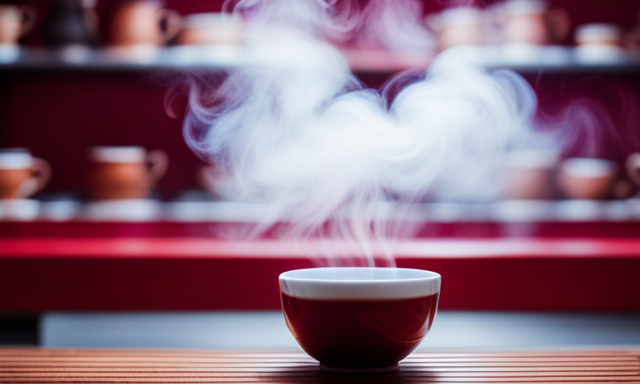
 Rooibos Tea2 months ago
Rooibos Tea2 months agoHow Many Times A Day Can You Drink Rooibos Tea






